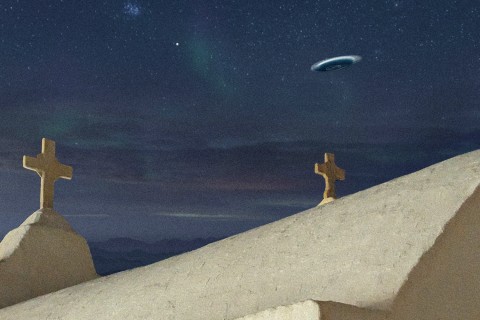Beyond a doubt
Seek My Face: A Novel. By John Updike. Knopf, 274 pp., $23.00.
At 70 John Updike is still adventurously experimental. His 20th novel is about American abstract expressionist artists in the period after World War II. It is also about God and the devil. These interlaced themes emerge dramatically right at the beginning: “For a long time I have lived as a recluse, fearing the many evidences of God’s non-existence with which the world abounds. The world, it has come to me slowly, is the Devil’s motley, colorful instead of pure. I restrict my present canvases to shades of grey ever closer together, as if in the pre-dawn, before light begins to lift edges into being. I am trying, it may be, to paint holiness.”
But first the context: In this narrative of a single day, Kathryn D’Angelo, a stylish, dark-haired 27-year-old New York City e-zine reporter on assignment in rural Vermont, interviews artist Hope Chafetz, a mellowed, meditative but chary and astute 79-year-old widow who was at the center of the New York art scene for many years. The daylong tug of dialogue, now sharply focused, now meandering, moves through those years as Hope answers questions both directly and obliquely, often pursuing private flashbacks undivulged to Kathryn.
The real-life persons on whom Updike models Hope and her husband, Zack McCoy, are Lee (Lenore) Krasner and Jackson Pollock, “America’s marvelous drip machine,” to whom Krasner was married for 11 years before Pollock’s death in a car accident. Unlike Krasner, Hope has been married three times, first to the emotionally erratic Zack, then to Andy Warhol–like collagist Guy Holloway—the father of her three children—and finally to mild-mannered stockbroker and art collector Jerome Chafetz.
The narrative interest resides in the changing roles of Kathryn and Hope—daughter and mother, therapist and patient, predator and prey. But it also lies in the significant differences of life perspective between the two—one young, urban, unmarried and professionally aspiring, the other old, rurally isolated, widowed and professionally canny.
That latter juxtaposition helps generate the novel’s peculiar religious themes. There is a lifelong consistency in Updike’s understanding of the ineradicable religious character of human consciousness, which this book continues. In 1997 when receiving an award as “a distinguished Christian person of letters,” Updike observed: “Is not Christian fiction, insofar as it exists, a description of the bewilderment and panic, the sense of hollowness and futility, which afflicts those whose search for God is not successful? And are we not all, within the churches and temples or not, more searcher than finder in this regard?”
This novel, through Hope’s sometimes conflicting comments, holds up the mirror to human doubt, presenting it as subtly, but only occasionally and never finally, eroded by a sense of God’s presence. That order is important: religious doubt is easy, indeed inevitable. Whatever faith we have always struggles uphill against it, but God’s presence is both painfully and joyfully unavoidable. In theological terms, Updike describes the presence and ambiguity of natural revelation through an odd combination of Barthian and Tillichian motifs. Evil is terribly real to Hope—and Updike—and “the Devil” is its symbol.
Late in the novel, however, Hope comments on “that rather pompous statement of mine you read to me” about the surface world of motley color which she had said was the Devil’s: “how weird of me to mention the Devil, I know you must think, but there is something out there, if you have any feeling for goodness at all, that resists it, that pushes the other way. I know you and your generation will think me quite mad, but God’s non-existence is something I can’t get used to, it seems unnatural.” Indeed, when Kathryn mentions the way in which physics indicates “there is no place for God in the universe,” Hope replies, “In us, dear. The place is in us, weak and silly as we are.” Later Hope qualifies, “I don’t really believe the world is the Devil’s. Or not only the Devil’s.”
And how does Updike link this sentiment to the nature of art? Art “has to be about us,” says Hope, “just a skin away from nothing. Not nothing perhaps, I don’t know what your religion is, but tumbling back into the radiance.” Interestingly, in his earliest autobiographical reflection (1962) Updike noted about art, “Blankness is not emptiness, we may skate upon an intense radiance because we see nothing else.” America’s early abstract expressionist art, especially through Pollock, is seen here as a tumbling back into that holy radiance, and thus, oddly enough, as a seeking of God’s face.





